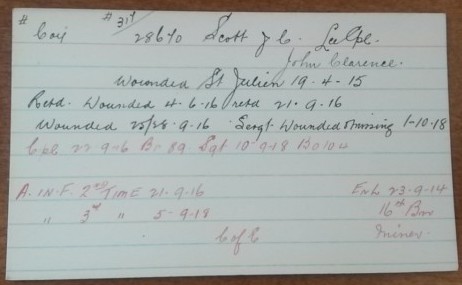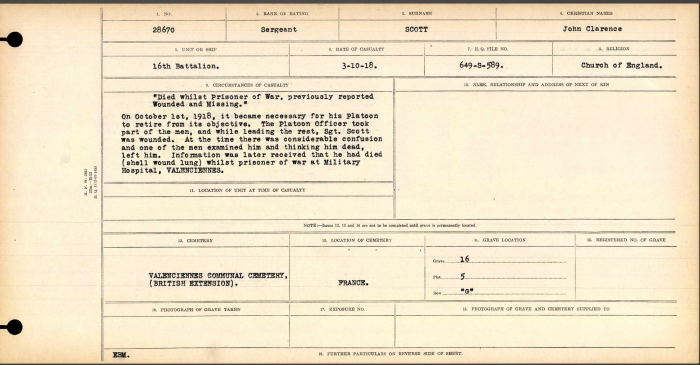Overview
John Clarence Scott was a miner as well as licensed inspector with the Victoria Police Department prior to his enlistment in the Canadian military in 1914. Scott served in the 16th (Canadian Scottish) Battalion for the entirety of his time at war. He was wounded four times before becoming a prisoner of war and killed in action during the 16th Battalion’s last major battle of World War One.
Before the Deployment Overseas
John Clarence Scott was born on 7 December 1873 in Newcastle upon Tyne in England. After his move to Victoria, he worked as both a miner and a licensed inspector in the Victoria Police Department. Scott was also a soldier with the 50th Gordon Highlanders. He had previous experience in the military as a mounted infantry soldier in the 5th Canadian Mounted Rifles and a member of the 13th Canadian Artillery Battery.[1] Scott enlisted in the 16th (Canadian Scottish) Battalion Canadian Expeditionary Force on 23 September 1914.[2]

Service in Europe (1915-1918)
The 16th Battalion arrived in France on 9 February 1915. Scott was suffered his first injury on 19 April 1915 while relieving a French regiment in the Ypres Salient area, just days before his battalion would enter into the Second Battle of Ypres. It appears he was back on the front line soon after as he was wounded on 4 June 1916 during the Battle of Mont Sorrel when the area was shelled continuously for twenty-four hours.[3] Scott recovered in England before returning to the 16th Battalion on 28 August 1916, he was promoted to Corporal on 22 September, before becoming wounded again only three days later at the Battle of the Somme.[4]
It was almost two years before Corporal Scott returned to his battalion for what would be his final battle. During this time Scott was a member of the Canadian Army Pay Corps in London, handling financial matters. On 6 September 1918, the corporal returned to France and was promoted to Sergeant just four days after.[5] However, at the Battle of Drocourt-Queant Line the initial promising advancement of the 16th Battalion was soon compromised and the unit became almost surrounding by German forces. When Sergeant Scott’s platoon began to retreat he was wounded by a shell and mistaken for dead. It was revealed that he was actually captured and brought to the military hospital in Valenciennes where he succumbed to his injuries on 3 October 1918.[6]

Written by Isobel Griffin
References
[1] Scott, John Clarence. “Attestation Paper,” Library and Archives Canada RG 150, Accession 1992-93/166, Box 8727-9
[2] Lieutenant-Colonel H. M. Urquhart.The History of the 16th Battalion (The Canadian Scottish) Canadian Expeditionary Force In the Great War, 1914-1919. Toronto: The MacMillan Company of Canada, Limited, 1932: 773.
[3] 16th Battalion (The Canadian Scottish) Fonds. “John Clarence Personnel Record,” University of Victoria Special Collections: Call No. SC338, Box 20, file 3
[4] History of the 16th Battalion, 773.
[5] 16th Battalion, “John Clarence Personnel Record.”
[6] Scott, John Clarence. “Circumstances of Death,” Library and Archives Canada RG 150, Accession 1992-93/314, Box 237.